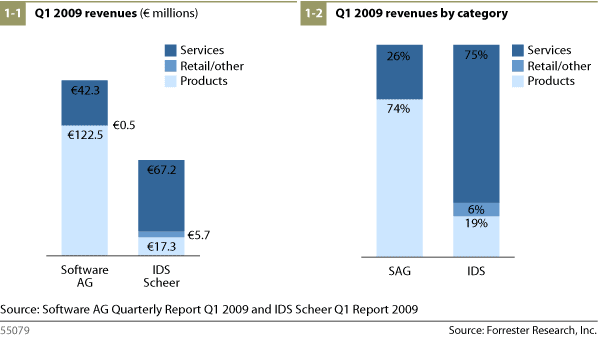Software AG On The Critical Path
Software AG announced today a significant change in their executive structure. After the acquisition of webMethods back in 2007, the second largest software vendor in Germany acquired IDS Scheer last year, at topic we explored already in this report.
If you follow Software AG over this time, you might realize that the way CEO Karl-Heinz Streibich runs a post merger process may involve dramatic disruptions in the executive structure of the company. Dave Mitchell, the former webMethods CEO left some months after that acquisition. Today, the Chief Product Officer, Dr. Peter Kürpick surprisingly left the company. Peter was a member of the executive board since 2005, and, although his contract officially runs until 2013, he is leaving at his own request immediately. He stood for the successful turnaround of Software AG’s product strategy and repositioned Software AG from an outmoded mainframe shop into a leading global integration player. The successful merging of Software AG’s mainframe and integration know-how with the newer webMethods product stack into one interoperable integration stack was one of Peter’s major achievements. Peter also took over the responsibility for Software AG’s ETS (mainframe) product strategy after the integration business reached a solid stability. He would have had the skills and experience to create a consistent technology stack spanning from the mainframe over the WebMethods integration up to the business architecture tools of IDS Scheer (ARIS).
If each major revenue driver would have been represented in Software AG’s executive board, the Software AG/webMethods part should continue to contribute the Chief Product Officer, while the IDS Scheer acquisition should bring in the consulting executive. The consulting services were actually the major contribution of the IDS Scheer acquisition and not the ARIS product as explored already in this report.
However, the new board structure puts Dr. Wolfram Jost in charge of Software AG’s overall product responsibility with quarterly revenue far beyond €100 million. This is a huge challenge for him compared with his responsibility of the €17 million ARIS volume in Q1 2009 before the acquisition.

Source: Forrester Report
The new structure introduces two executive boards. The executive board is the official legal function of a German AG board (Vorstand) and holds only four members (Streibich, Zinnhardt, Broadband and Jost). Secondly, the group executive board (GEB) is a Software AG internal management structure that holds these 8 members:
Chairman of the board and GEB: Karl-Heinz Streibich
Chief Financial Officer: Arnd Zinnhardt
COO EMEA (excl. DACH): David Broadbent
CTO R&D and Product Management & Marketing: Dr. Wolfram Jost
CEO Americas & APJ: Mark Edwards
Bereichsvorstand* DACH (Germany, Austria Switzerland): Kamyar Niroumand
Bereichsvorstand* Global Consulting Services: Ivo Totev
Bereichsvorstand* IDS Scheer Consulting: Josef Bommersbach
(“Bereichsvorstand” means an executive for a specific business unit.)
Although the staffing of executive boards is a highly emotional and personal issue, it indicates a significant shift in Software AG’s strategy and bears major risks:
- Software AG sets the management structure for further growth balanced with consistency. Obviously the management structure for the fastest M&A strategy is just a financial holding owning independent companies. Software AG’s executive board with Streibich, Zinnhardt and Broadbent ensures this financial performance and shareholder value. But, despite a financial holding structure, Software AG’s board values the customer demand for a consistent product strategy and appoints Dr. Wolfram Jost into the team of only four official executives. It will be his duty to bring webMethods, ARIS and the mainframe business to a consistent positioning. Based on Forrester’s previous research and methodology to measure positioning gaps, we believe this is good balance of interests
- Software AG’s technology stack is better integrated than a portfolio approach. A portfolio strategy is a totally different merger objective than an integrated technology stack. While an integrated technology stack provides acquired functionality seamlessly to existing users and developers, the portfolio approach is a much lighter integration or mash-up. It provides in many cases only integration on a UI level or import/export functionality of (meta) data from the different product families. Thus, the portfolio style leverages much less up-selling opportunities in each other’s install-base than the better integrated technology stack. Dr. Peter Kürpick and his team did a great job merging the product families of webMethods, the former Software AG EntireX and the recently acquired complex event technology from the German CEP expert RTM into an integrated stack. This raised the bar for other integration vendors like Progress Software over the past years. (Progress Software realized the downside of a loosely integrated portfolio and recently moved at least towards and closely integrated portfolio. See John R. Rymer’s blog.) Large customers and systems integrators will follow the ARIS integration carefully in the next months in this perspective. See also my upcoming SWOT analysis to be published here.
- The declining mainframe business is not leveraged. Although the webMethods and ARIS products grow faster than the traditional mainframe products, the latter represents 45% of the product revenues. Forrester believes that Software AG’s biggest organic growth potential is actually a revamped mainframe business based on modern development paradigms and tools. Vendors like Micro Focus are showing innovation for example with COBOL code running as managed .NET code together with new C# code even in the cloud. Customers’ (and analysts’) expectations are high, and we will see if Dr. Wolfram Jost will deliver on thought leadership for the whole Software AG group.
- Mind too many exec board disruptions. We have all observed SAP’s struggle over the last years after Shai Agassi left the executive board. It took the vendor years to re-establish a stable executive constellation and re-gain trust in the market. If Jost fails, Software needs quickly a strong person with product visions that create customer value.
Please leave a comment with your opinion of Software AG’s management change.
Stefan